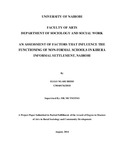| dc.description.abstract | Since the early 1990s Kenya has witnessed a rapid proliferation of non formal education
(NFE) programmes, which has radically altered the contours of the educational field.
There has been an increase in the number of non-formal and alternative approaches to
basic education programmes despite the introduction of free primary and secondary
education by the government as many children are still out of school. The enrolment of
NFE increased from 99,979 in 2003 to 143,409 pupils in 2008, an increase of 43.4
percent. Factors which have been found to influence increased enrolment in NFE are lack
of parents‟ ability to meet the high and often prohibitive cost of educating their children
such as provision of transport, hidden costs, physical and socio-cultural constraints, such
as cultural attitudes and gender bias, low retention, low completion rates and school
dropouts. The study sought to determine factors affecting the existence of non-formal
education in Kenya with focus on Kibera slum. The objectives were to establish the state
of learning conditions, forms and patterns of community participation in the management
of NFE culture, socio-economic factors and the level and forms of participation by the
learners on non-formal education in Kenya. The study adopted a survey research design
in which all the 9,854 learners and 280 teachers in the non formal education centres in
Kibera slum were targeted. The study used stratified random sampling method to select
336 pupils from the three locations of Kibera slum. Purposive sampling was used to
select 8 headteachers, 8 teachers, one District Education Officer, one County Education
Officer 3 chiefs and 3 community members from the sampled centers. The researcher
also interviewed the key informants. Data was collected both quantitatively and
qualitatively using observation guides, questionnaires and interview schedules. The
researcher self administered the research instruments. Data was analysed using both
descriptive statistics and content analysis. The study established that the community
comprised of community members, parents, NGOs, churches and to a small extent the
government. The participation by the community was in forms of building classrooms,
buying of school furniture and land for establishment and learning materials. The study
further established that most of the schools have classrooms and learners are provided
with meals. The study established that the formal and the non-formal education shared in
examination, syllabus, co-curricular activities among others. Most of the respondents
believe that the poverty has to a large extent influenced the NFE in Kibera as the
community view formal education as beyond their reach and therefore believed in
overdependence on aids which come in the form of NFE. The study recommended
increased government support towards NFE to ensure realization of education for all
children, the government should harmonize the formal and the non-formal education, and
finally, the government and other stakeholders need to work to support to improve
learning conditions for the learners by providing learning facilities | en_US |

